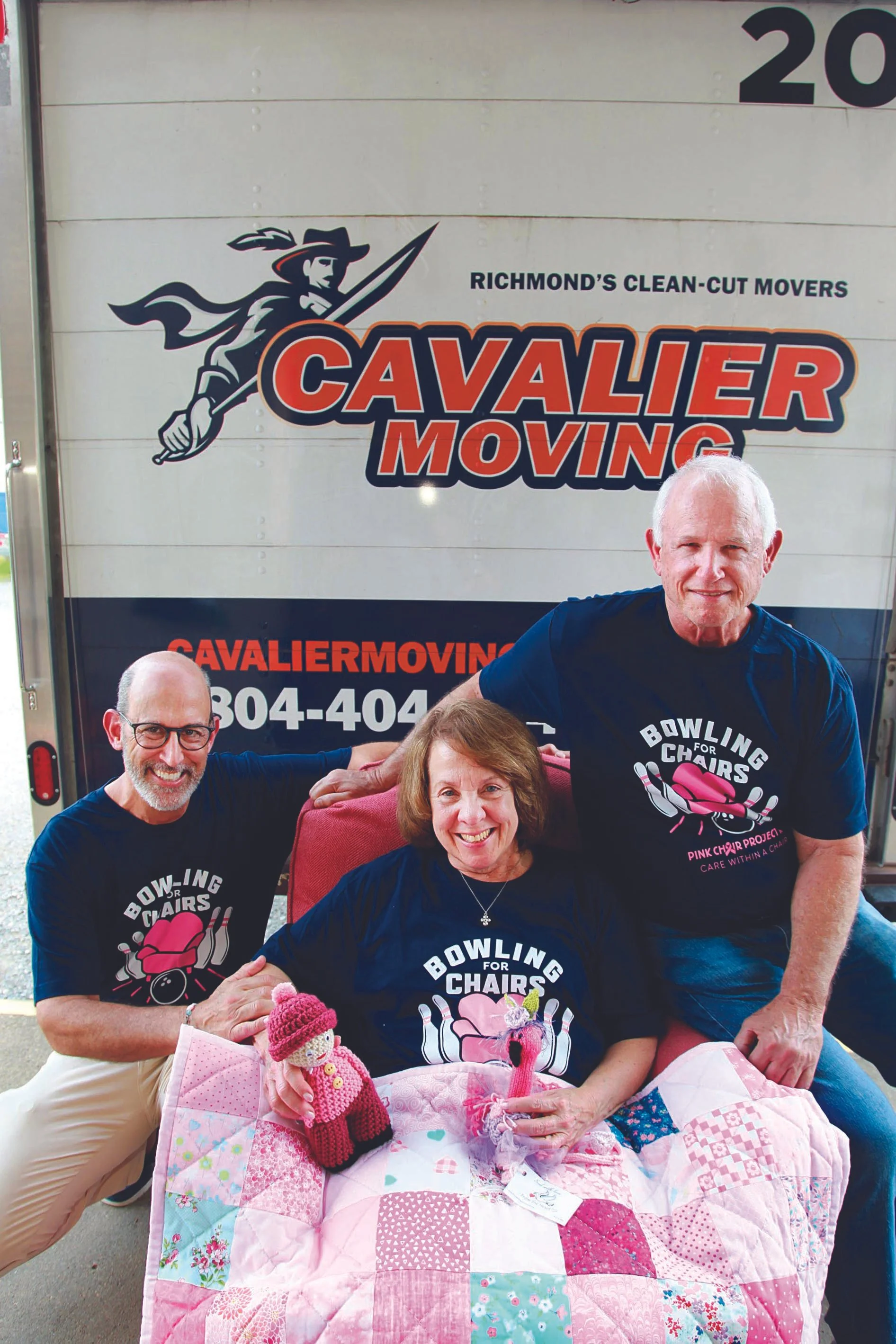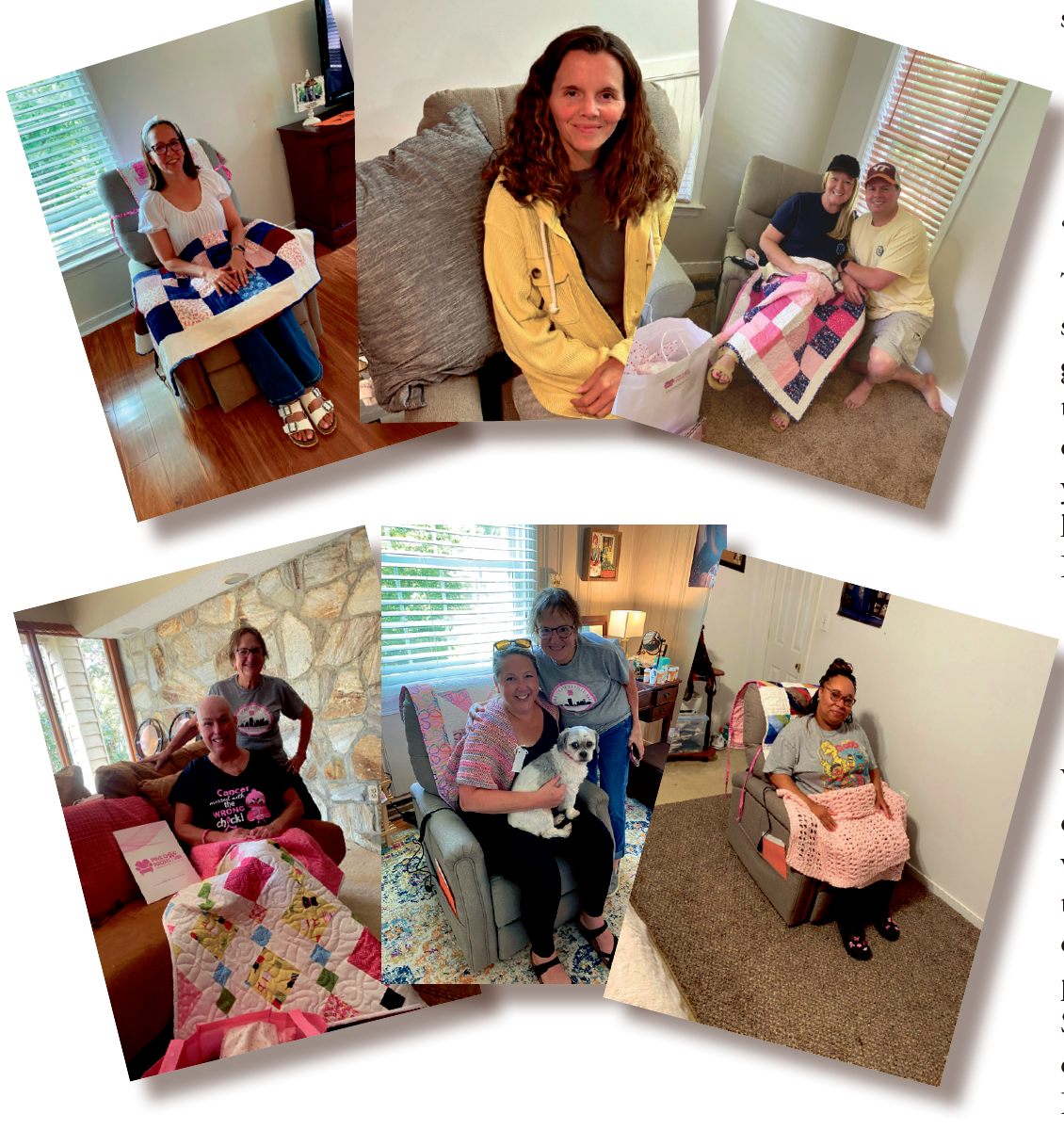From left to right: Bill Lambrinides, director of development for Pink Chair Project RVA; Linda Caruthers, founder of Pink Chair Project RVA; and Steve Thornton executive director of The Hawthorne Cancer foundation. Image by Rebecca D’Angelo
Linda Caruthers: Founder of Pink Chair Project RVA
by Charles McGuigan 07.2025
Some of the most important journeys we ever take are often ones that we didn’t want to make in the first place. They might be fraught with wrong turns, and aimless wanderings, and breakdowns in godforsaken landscapes, so we can arrive at a destination we didn’t even want to visit. But along the way we might meet people who change us, lead us toward a compassion that extends well beyond ourselves and our immediate neighbors, making the arrival worth the trip.
Linda Caruthers’ journey began two days before Christmas not long after our world was shut down by one of the smallest infective agents in creation that wreaks havoc with the living. She was scheduled to go to Johnston-Willis Hospital that day but was reluctant to go because of the Covid pandemic. She considered rescheduling, but something in the back of her mind convinced her to go.
She celebrated Christmas with her family, and a few days later, just before New Year’s Eve, she received a call from the radiologist.
“We need to bring you back in,” he told her. “We see something.”
“Well I think you’ve got the wrong person because I always self-examine, and I have no lumps,” she told him.
After a moment, the doctor said this: “With your type of breast cancer, there are no lumps,” and then added, “I’ve already made an appointment for you the first Monday of the New Year.”
So on January 4 of 2021, Linda spent the entire day at the Sarah Cannon Cancer Institute at Johnston- Willis. They performed a biopsy, along with another mammogram and an MRI, and a number of other scans, including an X-ray.
Later in the day, the radiologist on duty held the X-ray film up to a light box. And what appeared there looked for all the world like a galaxy of stars. These pinpoints of light were actually miniature tumors in every one of her milk ducts. That image burnt itself into Linda’s memory.
As he pulled the film away from the light source, the radiologist said “If Johnston-Willis didn’t have the three-dimensional mammogram machines, we would not have seen this for another year, possibly two years, and at that point you and I would be having a very different conversation.”
As she sat that day in a massive waiting room, all the women there were wearing masks and sat socially distanced. After all, it was at the height of the pandemic. But what she noticed that alarmed her was that many of the women waiting for the same kind of test results Linda was there for were young, some of them holding infants, others with toddlers.” I’m seventy,” she thought, “but these young women are little more than girls.”
That same day the radiologist would introduce her to Barbara, a nurse navigator, who would help Linda prepare for a massive mastectomy and its aftermath. She handed Linda a three-ring binder. On the first page there was a description of her diagnosis. One page included a list of items she would need for her recovery. This list included a variety of special garments and pillows along with a remote control recliner. Now, Linda, who had worked in the insurance business, knew that these items would probably not be covered by healthcare insurance.
“You’re looking at least a couple of thousand dollars here, and I’m in a position where I can do this,” Linda told Barbara. “But what about these young girls out here, maybe they have a career, maybe they’re single moms, maybe they just don’t have the money.”
Barbara shook her head. “Yes, it’s unfortunate,” she said. “But this is what you need to recover.”
“This makes no sense,” Linda said, and Barbara nodded.
This inadequacy gnawed at Linda. Her surgery was scheduled for three weeks later. Fortunately, one of her daughters owned a remote control recliner and her son-in-law set it up in Linda’s home, and it proved to be a life saver.
“I didn’t realize what a difference it would make,” Linda Caruthers, founder of Pink Chair Project RVA, tells me. She’s sitting across from me and flanked by Billy Lambrinides, director of development for Pink Chair Project RVA, and Steve Thornton, executive director of The Hawthorne Cancer Foundation.
“When you have your breasts and lymph nodes removed you lose your core strength,” Linda says, recalling what recovery from breast surgery was like. “You cannot open a cabinet. You literally can’t lift anything.”
Just after surgery, a nurse told her not to lift anything over ten pounds, which is roughly the weight of a gallon jug of milk. “I found that difficult to comprehend because I’ve always been very independent,” says Linda. But it was true.
Those in recovery from breast surgery also have to contend with drainage tubes that in some cases remain in place for more than a month. “You’ve got drainage tubes from the surgical site hanging down the side of your body,” Linda explains. “They’re very, very uncomfortable, and they get caught on doorknobs and chairs and all kinds of handles, so you learn early that you’ve got to wear a garment to keep these drainage tubes in place.”
In the three-ring binder given to her by the nurse navigator, it said those in recovery from this kind of surgery cannot lie down flat; you’ve got to be at an angle, and cannot turn over, But Linda had the remote control recliner, so she was able to sleep on an angle. And this recliner allowed her do so much more. A friend of hers who would later help her write a grant called the recliner “a sanctuary.”
“And she was right,” says Linda.
The way Linda describes it makes it sound like the protective palm of a gargantuan human hand. “It is a chair that literally holds you so you can’t turn over,” she says. “You’re healing better, you’re feeling better. I felt that I was held by this chair and secure in it. And I could put my laptop on my lap and I could write or I could read or I could crochet or I could color. I could do things that you can’t normally do after this kind of surgery.”
While recovering, Linda’s thoughts often drifted back to the young women she saw in the waiting room of the hospital, some of whom probably didn’t have the financial ability to purchase the sort of recliner she had. So she began an exhaustive search online and finally discovered The Pink Chair Project, the original one, out of Southbury, a small town in the Naugatuck Valley of Connecticut.
“So I picked up the phone, I called the number on their website and the founder answered,” Linda remembers. “Her story was fascinating to me because she and her daughter had both been diagnosed with breast cancer at the same time, and so she and her daughter made it their mission, after realizing what a difference a recliner made in their lives, to purchase twelve chairs.”
Several recipients of the Pink Chair Project RVA.
While visiting the website of the Hawthorne Cancer Foundation, which has its headquarters at Johnston-Willis Hospital, she noticed a photo of John Clair, a man she had worked with in her professional career in insurance.
”So I just called his cell phone and he answered and I told him about the Pink Chair Project, and John invited me to speak with the board and I met Steve Thornton, the man sitting next to me right here, who is executive director at Hawthorne,” says Linda. “So I shared my story and Steve said, ‘We really like your idea.’ And I said, ‘You do?’ And he said, ‘Yes.’ And it just took off.”
On about that time, in church one Sunday, Linda happened to see a man she had known for years. His name—Billy Lambrinides.
“I’ve known Billy since he was little boy,” Linda says. “I was friends with his parents. “I have no idea what possessed me but I told him about the Pink Chair Project.”
When she said this, Billy’s eyes widened. “Well I have a pink recliner,” he told Linda. Turns out his mother have been given it after a friend of hers passed and the family began thinning out her possessions.
“And so Billy donated the very first recliner to Pink Chair just from a conversation,” says Linda.
Billy, of course, is the pharmacist at the CVS in Bellevue and he serves as director of development for Pink Chair.
Pink Chair Project RVA is now one the three pillars of The Hawthorne Cancer Foundation. “That first year went fine - we were doing well, we saw potential,” says Steve Thornton, Pink Chair’s executive director. “We had our first fund raiser bowling event. That went well and we began to see interest pick up, and we knew we had something solid to support the cancer community.”
What this group offers breast surgery patients in recovery is phenomenal, and includes more than the remote control chair. “Each package has a cost of about $2,500 and includes the chair, along with a quilt, special garments, and pillows,” says Steve.
Right now to raise additional funds, the Pink Chair Project RVA is about to host two events—a golf tournament in September followed three weeks later by a night of bowling. “Now it’s about growing awareness in the community and letting people know how they can help us,” Steve says. “We need support to keep it going.”
To date, Pink Chair has given away 88 remote control recliner packages. “By this October we hope to hit one hundred,” says Linda Caruthers. “These chairs give hope. They make you feel secure and safe.”
Here are just three testimonials from folks who have benefited from the recliners.
“I just wanted to send a note to say thank you to the Pink Chair Project RVA for the gift of this wonderful chair!
“I am now 3.5 weeks post-surgery — and cancer-free! — and I’ve spent the majority of my recovery at my mother’s house, resting in this recliner. It has been so important in keeping me comfortable, preventing back pain, and allowing me to move around independently. It’s seen me through the hardest first week, a couple of setbacks, and even meeting my friend’s brand-new daughter!
“I’ve also been using everything else you gifted me — from the quilt to the cup to the tiny pillows, which have been a game changer in getting comfortable at night. I’m now back home (with the chair!) and typing this from it right now.
“Thank you for your work in running the Pink Chair Project RVA, and for your generosity and support as I’ve gone through surgery. This chair has truly been a gift, and I want you to know how very much I appreciate it.”
Jess
“This chair is incredible — and so beautifully designed, too! I’m still coming to terms with my diagnosis; cancer completely turned my world upside down. But receiving this chair, along with the weighted blanket, has brought me a sense of comfort and calm I didn’t know I needed. I’ve been feeling so unprepared, but now I feel a little more like… I can do this. I’m truly grateful to be connected with the Pink Chair Project.”
Sara
“Being a Pink Chair recipient brought me peace and comfort in knowing I had a team of wonderful people cheering me on.“
Joan
So consider knocking a few balls around the old golf course, or if your preference is a single ball consider rolling it down the alley, and earn a strike or two for a very worthy cause. For more information contact https://pinkchairprojectrva.com/contact-us-2/


